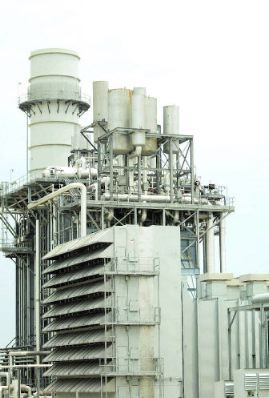TXU – $2,155,680,783 – don’t they get it?
March 9th, 2007
What about $2,155,680,780 don’t they understand? $3,593/kW. Â What about water contamination don’t they understand? What about 5.4 million tons of CO2 annually don’t the understand? And why is it no surprise that IGCC rears its ugly head on the heels of this “agreement.” Looks like there’s a lot of work to do in Texas!
TXU to try coal gasification process
Dallas Business Journal – 2:32 PM CST Friday, March 9, 2007
A holding company formed to buy TXU Corp. says it has started the planning process for two coal gasification demonstration plants in Texas.
Integrated gasification combined cycle plants, or IGCC, use a relatively new technology that is less polluting than traditional coal plants.
The holding company, Texas Energy Future Holdings LP, was formed by Kohlberg Kravis Roberts & Co. of New York and Fort Worth-based Texas Pacific Group to buy TXU Corp. (NYSE: TXU).
TXU has until April 16 to consider offers from other potential buyers on the deal worth $45 billion, including the assumption of TXU debt. The deal is expected to close in the second half of 2007.
TXU said it will request proposals from companies offering coal gasification with carbon dioxide capture, and the energy company’s new sustainable energy advisory board will review the proposals.
“We have been listening to and following the lead of Gov. Perry, legislators and interested parties all over Texas,” said Michael MacDougall of TPG. “We are announcing our intention to dedicate two sites for these new facilities. We are inviting representatives from communities across the state to contact the company with their views on the various site options. It’s time to start exploring how we bring better technology to Texas so we can generate clean, affordable, reliable power in the future.”
As part of the buyout offer, Texas Pacific and Kohlberg agreed to suspend efforts to build eight of 11 coal plants sought by TXU.
Clean air activists, who’ve fought construction of conventional coal-fired plants, said the proposed cleaner IGCC technology would be “a huge step forward.”
But they continued to criticize TXU’s ongoing plans to build two conventional coal-fired units south of Dallas at Oak Grove.
Those two proposed units, totaling more than 1,700 megawatts, would emit more smog-producing ozone than 350,000 cars, said Tom “Smitty” Smith, director of Public Citizen’s office in Texas.
“We urge them to take Oak Grove off the table and replace it with coal gasification there or elsewhere,” he said.
In unveiling the IGCC plan, TXU said it will select two or more competing IGCC technologies that can be developed and commercially deployed in power plants utilizing Powder River Basin and lignite coals, respectively, as the primary fuel source. The one using lignite coal, considered a more polluting coal, will be among the first such IGCC plants in the country, according to Texas Energy Future Holdings.
The project’s goal is to seek efficiency improvements, emissions reductions and technological breakthroughs, TXU Energy Future Holdings LP said.
Companies selected for the project will be involved in developing IGCC units at existing sites originally reserved for the now-suspended pulverized coal units.
TXU Energy provides electricity and related services to more than 2.1 million competitive electricity customers in Texas.
Rep. Dill, it ain’t 6.3 cents/kWh
March 7th, 2007
Rep. Dill stated in the House Environment Committee that the cost of electricity produced by Mesaba was “6.3 cents according to their lobbying and Mesaba wanted this to be part of the record.” (does anyone else still have their original powerpoint from January 2002 that promised 3.7 cents?)
Excelsior and Dill’s 6.3 cents/kWh may be the price that Excelsior is representing, and they may want that in the Committee record, but it is NOT the price established in the record of the PPA docket at the PUC.
The price established in the Dept. of Commerce analysis is 9.604-13.76 cents/kWh, which is 50-100% more than Rep. Dill’s report of 6.3 cents (and that is before any carbon capture is considered — nevermind that it is not feasible technically and is grossly cost prohibitive — another day for all of that).
9.604-13.76 cents/kWh — GOT THAT?!?!?!?!
YEAH, YOU, REP. DILL!
That number is from Rebuttal Testimony of MN Dept. of Commerce’s Dr. Elion Amit, p. 8, 24, 25, just move the decimal point
Meanwhile, we’re still awaiting the ALJ’s Recommendation in the PPA docket, it’s now two weeks overdue and we’ve had no word when to expect it. Excelsior is working overtime at the legislature — maybe they’ve created some more jobs — for more lobbyists!
And meanwhile, in the Delaware PSC’s analysis of a sort of similar situation, a comparison of 3 bids on RFP where power is not needed, the IGCC coal gasification proposal went down in flames. The analysis of DE PSC staff came to essentially the same conclusions — IGCC does not provide any great benefit to the environment nor does it provide a stable and reasonable price. DE staff put it dead last, in the low twenties out of 100 possible points. Once more with feeling – CHECK THESE OUT:
Delmarva RFP Bid Evaluation Report
Delaware Independent Consultant Report
For the full PPA docket, go to www.puc.state.mn.us and to “eDockets” and then to “Search Documents” for docket 05-1993
See also www.mncoalgasplant.com
Seems to me we’ve got critical mass and critical masses!
We’re going to swelter in the dark…
March 5th, 2007

There they go again, pulling that fear tactic, the “we’re gonna swelter (this is Texas after all) in the dark on a respirator without a job” because if they don’t build coal plants, we’re gonna have blackouts in August 2009. That’s a whole lot different than the NERC review of Texas generation and transmission reliability in the NERC 2006 Long-Term Reliability Assessment. Hey, duh, where do you think I learned about those mothballed gas plants???
Read the article from the Ft. Worth Star-Telegram below and count their examples of histrionic hype:
Deal to scrap new TXU plants leaves future supply uncertain
Mar 3 – McClatchy-Tribune Business News Formerly Knight Ridder/Tribune Business News – Dan Piller Fort Worth Star-Telegram, Texas
Those who worry about an upcoming shortage of electricity in Texas point to the week of August 9, 2009.
That’s when projections from the energy consortium that operates the state’s power grid show a shortfall of almost 1,000 megawatts in North Texas for what is likely to be a time of peak air-conditioning usage.
What the industry portrays as the Great Texas Blackout can’t be predicted with certainty. But numbers from the Electric Reliability Council of Texas provide a troubling preview.
Its outlook has become even more relevant in the past week, as TXU Corp. scuttled plans for eight of 11 coal-fired power plants in a high-profile compromise with environmentalists as part of a $45 billion buyout bid.
Come August 2009, ERCOT predicts, electricity demand in the state’s northern zone, which includes Dallas-Fort Worth, will total 25,827 megawatts. Dallas-based TXU and other generators will be able to produce 24,403 megawatts, according to industry estimates. One megawatt can power about 800 homes.
The sole hope for new generating capacity now is a 518-megawatt plant that TXU will build on its generating site at Sandow, northeast of Austin. If two other coal plants are approved, they would come online right at crunch time or shortly after, according to TXU and ERCOT.
TXU and ERCOT focused attention on the projections of a looming power shortage as TXU sought fast-track approval for the 11 coal-fired plants that would have increased its power production by almost 50 percent, helping meet increasing demand throughout the region for years to come.
But now that TXU has scaled back its plans, what do the projections look like?
Pretty dire, according to the industry. But there are cushions that the industry hasn’t discussed much.
Trudy Harper, president of Tenaska Power Services Co., which generates 3,200 megawatts in Texas and schedules electricity for TXU’s competitors, said many businesses have gone to interruptible power, which could be saved during peak loads, as well as other conservation measures that could forestall the day of reckoning.
Also, TXU could produce about 2,000 megawatts at older, mothballed plants that can be pulled back into service to bridge the shortage, gaining perhaps two or three years.
Calpine and NRG have generator plants in the works, including natural gas plants, that are expected to be online in three to five years.
Pat Wood, former chairman of the Texas Public Utility Commission and the Federal Energy Regulatory Commission, thinks returning the older plants to service would be enough to save the day.“The problem is those older plants are very expensive to operate, so that makes the electricity more expensive at a time when Texas is going to want to cut electricity costs,” Wood said.
He said more plant builders will step forward, particularly now that TXU has taken much of its plans off the table.
“You’ll see a mix of coal, natural gas and nuclear come on,” Wood said.
Harper agrees, saying: “There’ll be room for more generators. I think you’ll see them. But they take four or five years, so we don’t have much time to wait.”The head of the company that supplies most of the electricity in North Texas — and which has the majority of residential customers, thinks that the state would scrape through the potential shortage but that things would be tight.
TXU Chairman John Wilder said he is no more than “cautious” about the ability of TXU and other generators to meet local power demands in the next three to five years. “We can’t let the reserve margin get much lower,” he said.
Harper said: “I don’t let myself be panicked about it, but the generation situation could become scary.”
In coming years, the electricity margin is likely to become a much-discussed topic among Texas policymakers and business leaders. Considering that Texas’ margin of surplus electricity has fallen from more than 25 percent at the beginning of this decade to 15 percent this year and will be down to 10 percent by 2009, it is safe to say that projected demand will draw than passing interest.
Texas’ electricity surplus, and the resulting low rates, has been a prime engine for economic growth. Chambers of commerce, in wooing corporate relocations and new operations, could always tout cheap and available electricity, along with inexpensive land, no pollution problems and a relatively educated and energetic work force.
When demand peaks — in Texas, that’s on the hottest days of the year — the surplus dwindles and the marginal prices for the last units of electricity thrown onto the system can soar. Even with Texas’ historic margins, wholesale prices can jump to $300 per megawatt hour or more during peak periods.
But it is only during the hottest time of year that Texas comes near its peak usage and when the need for surplus power may approach the limit.
On Tuesday, the temperature in Fort Worth reached a balmy 79 degrees — warm enough for short sleeves but not enough for most folks to turn on the AC.
On that day, ERCOT reported a peak statewide demand of 34,500 megawatts, little less than half of the grid’s 71,756-megawatt capacity. North Texas consumed about 12,000 megawatts.
But on, a business day when schools were in session and the temperature reached 104 degrees, Texas’ grid reported a record demand of 63,330 megawatts.
About 20,000 megawatts were consumed on the North Texas portion of the grid.
“It’s really dramatic what air conditioning does to electricity demand, and the peak demand periods are caused when air-conditioning use is highest,” said Tenaska’s Harper.
OK, let’s do some math. 71,716 MW capacity, 63,330MW peak, 8,386MW of headroom, and there’s a lot more generation coming on line. Something tells me that they’re going to be just fine…
NRG the sore loser
March 2nd, 2007

Now NRG is trying to talk its way out of and around the devastating Delmarva RFP Bid Evaluation Report and the Delaware Independent Consultant Report.
Read their Reply to the reports:
Uh-huh, right, ja sure, whatever…
NRG TOP SECRET EMISSIONS INFO HERE
CLICK HERE for the Delaware PSC site for the RFP with all the tidbits.

OH MY DOG!!! Steve Corneli?!?!?!
March 2nd, 2007

Steve Corneli, V.P., NRG (fair use, from VOA)
Folks, this too is hilarious! A little bovine forwarded this article:
In that article is most disturbing news:
Traditional coal-burning power plants are a major source of greenhouse gas emissions. But Steven Corneli of NRG, one of America’s largest power producers, says his corporation is exploring a technology that takes the carbon dioxide out of coal before it’s burned at the power plant, without harming profitability.
“The way that is done,” says Corneli, “is to heat the coal up in a controlled atmosphere, which degrades it into combustible gases. These gases then can be cleaned up to remove the vast majority of the regular pollutants.”
During the next stage of the process, the carbon dioxide is chemically taken out of the gas stream and captured, and the combustible portion of the gas is run through a regular power generator and turned into electricity.
This statement is from the guy who wrote two of the most important reports to come out of the A.G.’s office:
These reports were two of those DUH! moments in history. The stranded assets report was such a hoot. It was at a time when NSP was at the legislature going on about how they’d have to be compensated for their “stranded costs” because they claimed the nuclear plants wouldn’t be workable under deregulation, and in walks Corneli with the report that says, “Earth to Mars, these nuclear plants aren’t ‘stranded costs,’ they’re stranded assets.” In short, NSP ought to be paying US!! And not only that, he noted that NSP owed us a rate decrease!
The deregulation report was much the same, and it pretty much ended discussion of deregulation in Minnesota. How stupid did NSP think we were, we’re a low cost state, and if deregulated, costs would logically rise to meet the level in the cesspool… er… market.
This is the same Steve Corneli? Stumping for IGCC???? How can this be? Looks like I’m going to have to rough him up in the hall again… er… have a little discussion…

